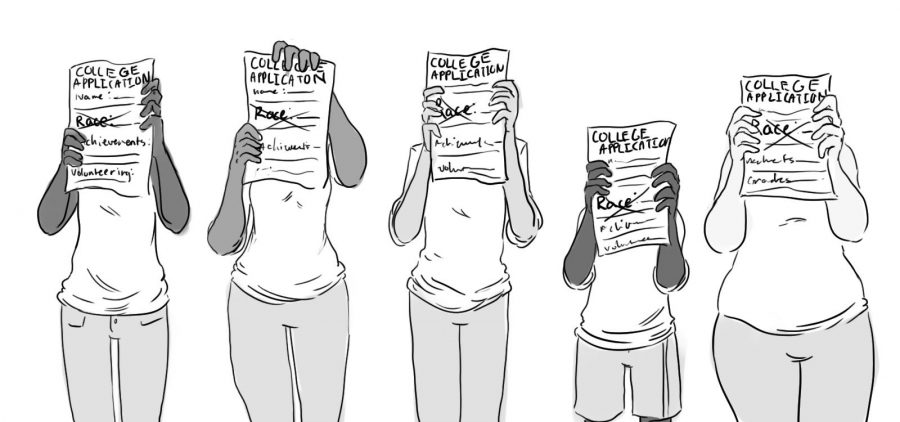Affirmative Action: Addressing the Wrong Problem
Economic Consideration Needed for Diversity
I’m only a sophomore, but the idea has been on my mind since my sister, currently a freshman in college, started thinking about it her junior year. The stressful process for her gave me an uncomfortably real idea of how much pressure college applications put on high school students trying to present their good qualities to admission officers. However, it could be said that there is more to present to these officers than grades and standardized testing scores. If one puts aside race and gender, one factor that should be considered by colleges should be socioeconomic background.
According to the Oxford dictionary, affirmative action is “favoring those who tend to suffer from discrimination; positive discrimination.” It is often employed by colleges who are looking to accept a more diverse population into their school, by focusing their recruitment and acceptance efforts on high schools with a more diverse population. Similarly, during the application process, applicants’ race is a factor colleges bear in mind while deciding whom t o accept.
In America, race should not be considered as something that would give one a higher chance of getting into college, because it does not affect one’s odds in the way that socioeconomic background does. This background, however, should be taken into account, because a student’s social and economic standing majorly affects one’s qualifications.
For example, many high schools in lower-income neighborhoods do not offer AP courses, while others offer a variety. This leads to discrepancies in compared GPAs, meaning that when compared, students may not weigh up. Admissions officers should note an applicant’s high school courses and other factors out of their control, such as the quality of education as a whole.
Certain colleges do make it a priority to acknowledge this while looking over applications. Stanford, for example, offers tuition scholarships, covering and limiting fees for students whose parents make under certain amounts each year. A scholarship based on economic background not only is more understandable usage of affirmative action, but is also more fair, as it is an important aspect of a student’s ability to enter college.
This topic has been heavily debated over recent years. California’s Proposition 209, which, according to Ballotpedia, “prohibit[s] from discriminating on the basis of race, sex or ethnicity,” has been argued against by many schools who feel that they accept too many people of one racial group, and would like to use affirmative action as a means to diversify them. On a broader scale, Initiative 200, which was passed in 1998, prevents employers, admissions officers and contractors from discrimination, based on race, sex or ethnicity.
The concept of affirmative action was obviously developed in order to give a fair chance to people who might not get equal opportunities to other members of society, but it still has a long way to go. “Positive discrimination” toward members of a certain racial group, or towards people of a specific gender, is not the best way to address the problems within the process of college admissions. In order to improve affirmative action, admissions officers should be sure to make it exclusive to applicants’ socioeconomic background to put everyone on a fair playing ground.
A Process that Needs Rewriting
I’m what pop culture likes to call a Whasian, a person who is technically half-white and half-Asian.
Throughout my life I’ve been fortunate to never experience discrimination because of my blend of races, but only recently have I discovered a form of racial discrimination that doesn’t stem from classmates, but from a group of intellectual adults that constitute the college admissions board.
Although college does not translate to a perfect life, there is a high amount of stress among students to attend “top-tier” colleges, and students are willing to go to great lengths to manipulate the application to ensure acceptance. I was told that in a battlefield of intellectual Asians fighting for the same top colleges, I could apply as “white” and be protected by a shield that covers my Asian side.
Because of race-based affirmative action, there is a heavy pressure exerted on the question of race on college applications. I see this pressure weighing on my brother, a senior currently applying to colleges, because of his multi-racial status. These recent weeks have made me realize that in two years I will have to apply and determine the answer to a question that may plant or uproot a tree that can branch off to many opportunities. I’m faced with a stark choice between a selection of little bubbles spaced less than an inch apart; a choice that may determine my entire future.
This quandary I face is not unique to me whatsoever. Countless multi-racial students are concealing the Asian aspect of their identity on college applications. Although the proportion of Asian-Americans that meet college admission standards to the total amount of Asian-Americans is exceedingly high, in order to have an equal chance of admission, they must have test scores higher than applicants from other racial backgrounds. This happens because Asian-Americans are not evaluated as individuals, but are evaluated in comparison to the thousands of other high-achieving Asians.
Affirmative action has been a controversial topic in the United States for decades. Ward Connerly, an anti-affirmative action activist of African, Native American and European descent, believes that affirmative action is a new form of racism. In 1996, he fought for Proposition 209 — a proposition that banned gender and race based affirmative action in California’s public institutions. With over five million votes, Proposition 209 passed. Washington, Michigan, Nebraska, Arizona and Oklahoma have also banned affirmative action in their public institutions.
America is built on the idea of a meritocracy — the concept that success should be based off of ability. However, when admissions offices look at race, it destroys this fundamental idea. Instead of being accepted for what good qualities applicants have inside themselves, applicants are being turned down because of a born characteristic that they have no control over.
Multi-racial students have undermined and rendered race-based affirmative action useless, as these students have the power to determine what race they put up to the college admissions board and what race to cover in shadow. Because of this common gamble that many prospective college-students face, race-based affirmative action no longer truly helps disadvantaged minorities.
Then why continue to require race on college applications? The Supreme Court ruling Hopwood vs. Texas in 1996 decreed that favoring races because of historical discrimination cannot be a factor in admission decisions, but looking at race to achieve diversity can be a factor. Many maintain that affirmative action ensures diversity on campus, which exposes students to a range of cultures and the unique ideas that come along with those cultures.
But simply having people of different races doesn’t automatically translate into differences of opinions. People who have ancestry from a common continent don’t necessarily have the same opinions or even the same folk culture.
Take me, for example. You could say I come from both Asian and European descent, but that doesn’t mean half of my opinions are like an Asian person’s and half of my opinions are like a white person’s. Because I’m a sixth generation American, I don’t know anything about my heritage, and I’ve never even set foot on the entire continent of Asia. My thoughts, my biases and my prejudices all come from America, not from Asia nor Europe.
Colleges looking to create diversity through race alone is not the smartest choice, as there are many loopholes that come with it. Forcing people to categorize themselves as a particular race only reinforces stereotypes, even though people from a certain ethnic background don’t necessarily have that cultural upbringing.
Colleges should stop looking for diversity through race, as race doesn’t necessarily correlate to culture. Instead, diversity should be maintained by selecting individuals with different and unique interests. Having a variety of personal interests and not just a variety of races on campus ensures that race-based affirmative action’s original intent of diversity is accomplished.





Kimia Izadinia | Dec 7, 2016 at 10:03 am
“In America, race should not be considered as something that would give one a higher chance of getting into college, because it does not affect one’s odds in the way that socioeconomic background does.” This is UNBELIEVABLY ignorant. How could one say that race doesn’t affect one’s odds?? Race is a HUGE factor of the disadvantages one faces in life, and the writer as a non-black and non-latino POC should really re-evaluate her privilege. OUR WHOLE CRIMINAL JUSTICE SYSTEM WAS HISTORICALLY BUILT TO OPPRESS BLACK PEOPLE, and IT’S THE SAME SYSTEM! How could you live with that your entire life, and NOT have it affect your education at all? ALSO this whole article is built on a complete fallacy. Colleges DO look at your socioeconomic background and you’re given a chance to explain how your circumstances have affected that. And they DO look at that during the “affirmative action” process. Race is the SOCIO of socioeconomics.
Also for the second article– to say that you are facing discrimination is undermining the discrimination that black and Latino students face in the college decision process and in life in general. Colleges care more about you, and THEN look at races. WE NEED EQUITY not EQUALITY. Your race, and your skin color DIRECTLY correlate with how you have been treated and your experience as a person.